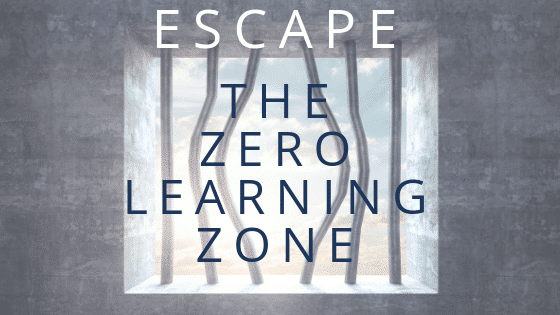
This month’s issue of Educational Leadership from ASCD has a thoughtful piece from Dr. Jim Knight of the Instructional Coaching Group. In it, Dr. Knight explores the Zero Learning Zone that many teachers find themselves in when they begin to put up blocks to continuous growth through professional learning. The full article has a wealth of great advice from this instructional coaching guru. From the many tips in the article, the following 4 are our favorites
What is the Zero Learning Zone?
According to Knight, “We step into the Zero-Learning Zone whenever we act, consciously or unconsciously, in ways that block our own learning.” As educators, each of us makes a strong commitment to learning, so much so that we dedicate our careers to it. Of course, when we turn that impulse to learn upon ourselves, it can be easy to avoid the subject. Many people who spend their days teaching others are hesitant when it comes time for them to learn. We say we’re too busy, or that our teaching habits are successful and therefore don’t need revision. And while that may be true, Knight reminds us of this quote:
Who dares to teach must never cease to learn.
—John Cotton Dana
When we avoid the opportunity to learn about our own teaching and new ways to improve it, we are entering the Zero Learning Zone. Importantly, Knight has some helpful tips to nudge us onto the path toward change, improvement, and increased success!
Tip # 1: Do you have hope?
Knight argues that a teacher who has no hope for improvement in their classroom will struggle to get out of the Zero Learning Zone. Of course, when you’ve struggled with the same disruptive student, or the same inability to successfully teach a difficult concept, or any of the other myriad challenges teachers face daily in the classroom, it can be easy to become hopeless. If you have no hope that your students are able to learn a new concept or positively contribute to the learning environment, no amount of training, self-reflection, or coaching is going to help you move forward. But hopelessness can come in several different guises. You can lose hope in a student, a school environment, parental support, or even in yourself. But in every teaching environment, there is something to feel hopeful about. Perhaps you can feel hopeful that your students will enter the classroom in accordance with a newly taught and rehearsed routine. Or maybe you can feel hopeful that, with some advanced planning, you will find the time to call at least one parent a week to highlight a student’s positive contribution to her learning. The key is to find one change to hope for and start there.
Before you begin on any professional learning journey, Jim Knight encourages you to ask yourself three questions:
- Do I have a clear, specific goal?
- Do I have strategies I can use to hit the goal?
- Do I believe I can hit the goal?
If the answer is no to any of these questions, don’t embark on the path to learning yet. Pause to collect the resources you need first. Learning is difficult, and if you aren’t fully equipped, it’s easy to lose hope along the way. If you’ve even got a glimmer of doubt about the success of your professional learning experience, the next three tips will help you secure the hope you’ll need for the voyage.
Tip # 2: Set targeted goals
In Jim Knight’s newest book, The Impact Cycle, he uses a handy acronym to help you remember how to set effective goals for professional learning:
Positive
Easy to Achieve
Emotionally Compelling
Reachable
Student Focused
The Impact Cycle has a great, in-depth exploration of PEERS goals. But Knight doesn’t spend much time on its most brilliant attribute: the name itself. PEERS implies that goals should be co-created by two equals. If your goal has been set for you by an appraiser or some other supervisor, it’s not likely to engender the kind of enthusiasm we really need to want to grow. Of course, many of us will dutifully work on a goal that has been assigned to us, but few of those goals will lead to long-term, measurable improvement in work. Rather, a PEERS goal is set by, you guessed it…peers. In other words, the person for whom the goal is set should also be at least one of the people setting the goal. Ideally, you should take the lead in setting your own goal. Secondly, the goal should be set in a collegial relationship. In other words, find a colleague you trust and respect to bounce ideas off of as you begin to find a goal that is positive, easy to achieve, emotionally compelling, and student-focused.
And if that isn’t the case for your workplace, it’s not like the goal that your appraiser sets for you has to be the only goal you work toward.
Tip # 3: Keep it simple
Teaching is complex. Don’t make it harder by trying to learn a complicated set of new practices all at once. That’s why most capital-P, capital-D “Professional Development” doesn’t work. In the day-long workshop or the weekend conference, you’re forced by the very nature of the format to cram entirely too much information into the experience. Even some of the well-intentioned book studies that seem increasingly popular in schools can be too much. How many of you have heard a similar directive from a leader who decides it’s time for people to learn: “Alright everyone, go read this 40 page chapter from our book and come prepared to discuss it for an hour after school.” (Or perhaps you’ve been that leader…it’s ok, we understand). In the busy lives of those tasked with educating the minds of tomorrow, taking time to learn something new can almost seem selfish sometimes. At best, it’s given the verbal attention it deserves, but gets logistical short-shrift. Professional learning gets pushed to the margins of the day, or of the week, or perhaps the year. And because we all agree that it’s important for us to learn to improve our craft, we think we need to take those few stolen moments and jam them with as much information as possible. But if what you’re trying to do is learn to change, this is the worst strategy imaginable. If you try and change too much all at once, you’ll end up changing nothing at all.
Instead, pick one thing. And one thing isn’t “literacy strategies” or “classroom management” or “student engagement.” Those are still far too large of a task. Whittle your professional learning goal down to something that can pierce through your routine. And if you chose something so narrow that you learn to change in a week, GREAT! Pick something else next week! Imagine what a difference that will make over the course of a year!!!!
Tip # 4: Treat yourself with compassion
This is perhaps simultaneously the simplest tip and the hardest to achieve. To quote Jim Knight, “Teachers are often harder on themselves than anyone else would ever be, and certainly harder on themselves than they would ever consider being with a friend.” Knight reminds us that, if we’re learning something meaningful, we’re likely to struggle at least a little bit during the process. Take the time during that process, especially during the hard parts, to pause and be kind to yourself. If you’re watching yourself on video, for instance, and the process feels uncomfortable…hit pause. Take a deep breath. Remind yourself that the thing you just saw that made you cringe is not the entirety of your teaching practice. Our classrooms are made up of endless variables. Some of them will be near perfection. Others…won’t. Don’t let your desire to smooth the rough-spots inhibit your ability to see the beauty that already exists.
There’s a reason it’s called professional development. If your professional learning experiences aren’t helping you to grow and become more skilled, they’re a complete waste of time. If you don’t change because of your professional development, ask yourself why. Have you lost hope in your ability to improve? Do you not really know what you need to change? Are you just doing this because someone else told you to? Is it overwhelming? If the answer to any of those questions is yes, it’s pretty clear that you’re in the Zero Learning Zone. There’s no reason for you to do one more thing without taking the time to get out of the Zone before proceeding. But don’t do it alone. Find someone you trust and respect. We all learn better when we learn together.

